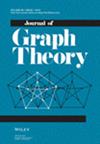A Ramsey-Type Theorem on Deficiency
IF 1
3区 数学
Q2 MATHEMATICS
引用次数: 0
Abstract
The Ramsey Theorem says that a graph has bounded order if and only if contains no complete graph or empty graph as its induced subgraph. The Gyárfás-Sumner conjecture states that a graph has bounded chromatic number if and only if it contains no induced subgraph isomorphic to or a tree . The deficiency of a graph is the number of vertices that cannot be covered by a maximum matching. In this paper, we prove a Ramsey-type theorem for deficiency, that is, we characterize all the forbidden induced subgraphs for graphs with bounded deficiency. In this application, we answer a question proposed by Fujita et al. (2006).
关于亏的一个ramsey型定理
拉姆齐定理说一个图G有有界阶当且仅当G不包含完全图Kn或者空图en作为它的诱导子图。Gyárfás-Sumner猜想指出一个图G有有界色数当且仅当它不包含与K n或a同构的诱导子图树;图的不足之处在于不能被最大匹配覆盖的顶点的数量。本文证明了缺的一个ramsey型定理,即刻画了有界缺的图G的所有禁止诱导子图。在这个应用中,我们回答了Fujita等人(2006)提出的一个问题。
本文章由计算机程序翻译,如有差异,请以英文原文为准。
求助全文
约1分钟内获得全文
求助全文
来源期刊

Journal of Graph Theory
数学-数学
CiteScore
1.60
自引率
22.20%
发文量
130
审稿时长
6-12 weeks
期刊介绍:
The Journal of Graph Theory is devoted to a variety of topics in graph theory, such as structural results about graphs, graph algorithms with theoretical emphasis, and discrete optimization on graphs. The scope of the journal also includes related areas in combinatorics and the interaction of graph theory with other mathematical sciences.
A subscription to the Journal of Graph Theory includes a subscription to the Journal of Combinatorial Designs .
 求助内容:
求助内容: 应助结果提醒方式:
应助结果提醒方式:


